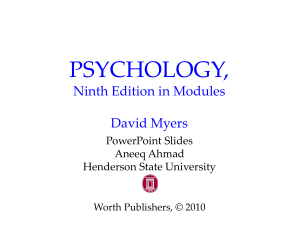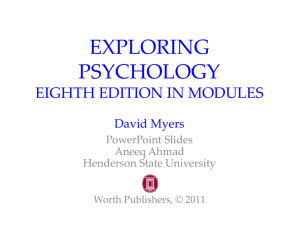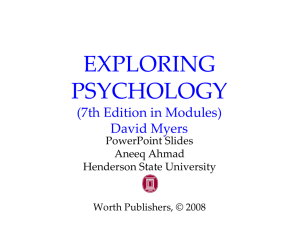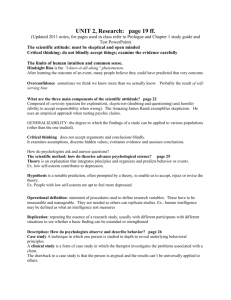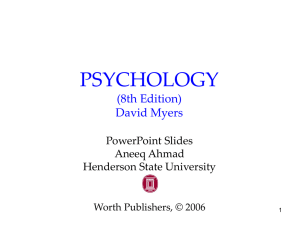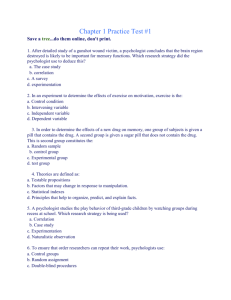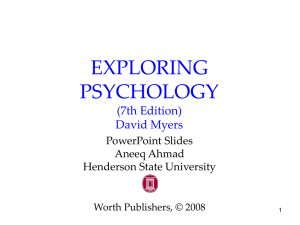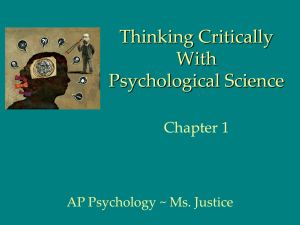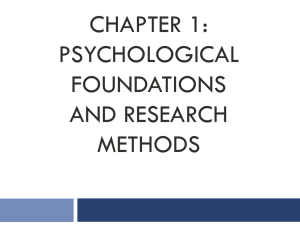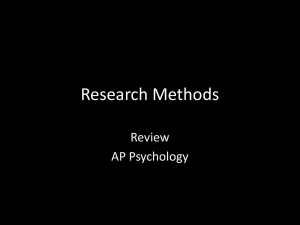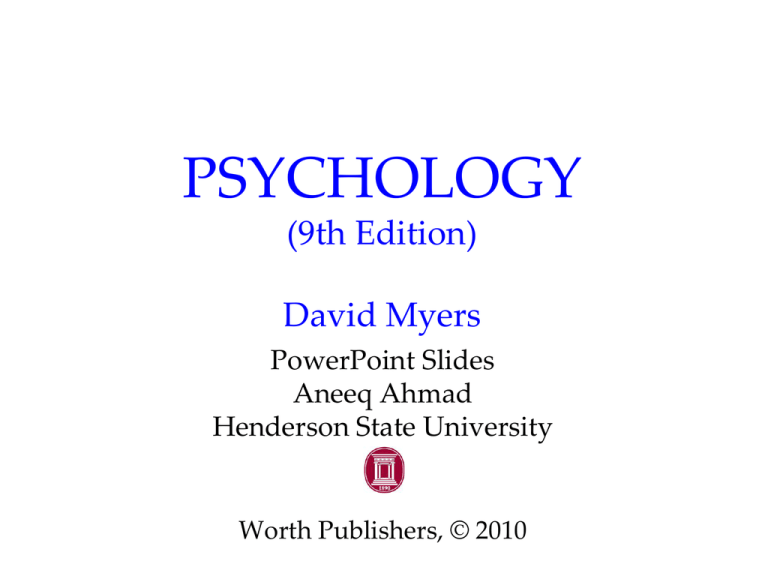
PSYCHOLOGY
(9th Edition)
David Myers
PowerPoint Slides
Aneeq Ahmad
Henderson State University
Worth Publishers, © 2010
Thinking Critically With
Psychological Science
Chapter 1
The Need for Psychological
Science?
Did We Know It All Along?
Hindsight Bias
Overconfidence
The Scientific Attitude
Critical Thinking
How Do Psychologists Ask
and Answer Questions?
The Scientific Method
Description
Correlation
Experimentation
Statistical Reasoning in
Everyday Life
Describing Data
Making Inferences
Frequently Asked Questions
About Psychology
Why Do Psychology?
1. How can we differentiate between
uniformed opinions and examined
conclusions?
2. The science of psychology helps make
these examined conclusions, which leads
to our understanding of how people feel,
think, and act as they do!
What About Intuition & Common
Sense?
Many people believe that intuition and common
sense are enough to bring forth answers regarding
human nature.
Intuition and common sense may aid queries,
but they are not free of error.
Limits of Intuition
Personal interviewers may
rely too much on their “gut
feelings” when meeting
with job applicants.
Taxi/ Getty Images
Hindsight Bias
Hindsight Bias is the “I-knew-it-all-along”
phenomenon.
After learning the outcome of an event, many
people believe they could have predicted that very
outcome. We only knew the dot.com stocks would
plummet after they actually did plummet.
Overconfidence
Sometimes we think we
know more than we
actually know.
How long do you think it
would take to unscramble
these anagrams?
People said it would take
about 10 seconds, yet on
average they took about 3
minutes (Goranson, 1978).
Anagram
WREAT
WATER
ETYRN
ENTRY
GRABE
BARGE
The Scientific Attitude
The scientific attitude is composed of curiosity
(passion for exploration), skepticism (doubting
and questioning) and humility (ability to accept
responsibility when wrong).
Critical Thinking
Courtesy of the James Randi Education Foundation
Critical thinking does
not accept arguments
and conclusions blindly.
It examines
assumptions, discerns
hidden values,
evaluates evidence and
assesses conclusions.
The Amazing Randi
How Do Psychologists Ask &
Answer Questions?
Psychologists, like all scientists, use the
scientific method to construct theories that
organize, summarize and simplify
observations.
Theory
A theory is an explanation that integrates
principles and organizes and predicts
behavior or events.
For example, low self-esteem contributes to
depression.
Hypothesis
A hypothesis is a testable prediction, often
prompted by a theory, to enable us to
accept, reject or revise the theory.
People with low self-esteem are apt to feel
more depressed.
Research Observations
Research would require us to administer
tests of self-esteem and depression.
Individuals who score low on a self-esteem
test and high on a depression test would
confirm our hypothesis.
Research Process
Description
Case Study
A technique in which one person is studied in
depth to reveal underlying behavioral principles.
Susan Kuklin/ Photo Researchers
Is language uniquely human?
Survey
A technique for ascertaining the self-reported
attitudes, opinions or behaviors of people
usually done by questioning a representative,
random sample of people.
http://www.lynnefeatherstone.org
Survey
Wording Effects
Wording can change the results of a survey.
Q: Should cigarette ads and pornography be
allowed on television? (not allowed vs. forbid)
Survey
Random Sampling
If each member of a
population has an equal
chance of inclusion into a
sample, it is called a
random sample
(unbiased). If the survey
sample is biased, its
results are not valid.
The fastest way to know about the
marble color ratio is to blindly
transfer a few into a smaller jar and
count them.
Naturalistic Observation
Observing and recording the behavior of animals in the
wild and recording self-seating patterns in a multiracial
school lunch room constitute naturalistic observation.
Courtesy of Gilda Morelli
Descriptive Methods
Summary
Case studies, surveys, and naturalistic
observation describe behaviors.
Correlation
When one trait or behavior accompanies
another, we say the two correlate.
Indicates strength
of relationship
(0.00 to 1.00)
Correlation
coefficient
Correlation Coefficient is a
statistical measure of the
relationship between two
variables.
r = + 0.37
Indicates direction
of relationship
(positive or negative)
Scatterplots
Perfect positive
correlation (+1.00)
Scatterplot is a graph comprised of points that are
generated by values of two variables. The slope of
the points depicts the direction, while the amount
of scatter depicts the strength of the relationship.
Scatterplots
Perfect negative
correlation (-1.00)
No relationship (0.00)
The Scatterplot on the left shows a negative correlation,
while the one on the right shows no relationship between
the two variables.
Data
Data showing height and temperament in people.
Scatterplot
The Scatterplot below shows the relationship
between height and temperament in people. There
is a moderate positive correlation of +0.63.
Correlation and Causation
Correlation does not mean causation!
or
Illusory Correlation
The perception of a relationship where no relationship
actually exists. Parents conceive children after adoption.
Adopt
Confirming
evidence
Disconfirming
evidence
Do not
adopt
Disconfirming
evidence
Confirming
evidence
Michael Newman Jr./ Photo Edit
Conceive
Do not
conceive
Order in Random Events
Given random data, we look for order and
meaningful patterns.
Your chances of being dealt either of these hands is
precisely the same: 1 in 2,598,960.
Order in Random Events
Given large numbers of random outcomes, a few
are likely to express order.
Jerry Telfer/ San Francisco Chronicle
Angelo and Maria Gallina won two
California lottery games on the same day.
Experimentation
Exploring Cause and Effect
Like other sciences, experimentation is the
backbone of psychological research. Experiments
isolate causes and their effects.
Exploring Cause & Effect
Many factors influence our behavior. Experiments
(1) manipulate factors that interest us, while other
factors are kept under (2) control.
Effects generated by manipulated factors isolate
cause and effect relationships.
Evaluating Therapies
Double-blind Procedure
In evaluating drug therapies, patients and
experimenter’s assistants should remain
unaware of which patients had the real
treatment and which patients had the placebo
treatment.
Evaluating Therapies
Random Assignment
Assigning participants to experimental (breastfed) and control (formula-fed) conditions by
random assignment minimizes pre-existing
differences between the two groups.
Independent Variable
An independent variable is a factor manipulated
by the experimenter. The effect of the independent
variable is the focus of the study.
For example, when examining the effects of breast
feeding upon intelligence, breast feeding is the
independent variable.
Dependent Variable
A dependent variable is a factor that may change
in response to an independent variable. In
psychology, it is usually a behavior or a mental
process.
For example, in our study on the effect of breast
feeding upon intelligence, intelligence is the
dependent variable.
Experimentation
A summary of steps during experimentation.
Comparison
Below is a comparison of different research
methods.
Statistical Reasoning
Statistical procedures analyze and interpret data
allowing us to see what the unaided eye misses.
Composition of ethnicity in urban locales
Statistical Reasoning in Everyday Life
Doubt big, round, undocumented
numbers as they can be misleading and
before long, become public
misinformation.
Apply simple statistical reasoning in
everyday life to think smarter!
Describing Data
A meaningful description of data is important in
research. Misrepresentation may lead to
incorrect conclusions.
Measures of Central Tendency
Mode: The most frequently occurring score
in a distribution.
Mean: The arithmetic average of scores in a
distribution obtained by adding the
scores and then dividing by the number
of scores that were added together.
Median: The middle score in a rank-ordered
distribution.
Measures of Central Tendency
A Skewed Distribution
Measures of Variation
Range: The difference between the highest and
lowest scores in a distribution.
Standard Deviation: A computed measure of
how much scores vary around the mean.
Standard Deviation
Normal Curve
A symmetrical, bell-shaped curve that
describes the distribution of many types of
data (normal distribution). Most scores fall
near the mean.
Illusion of Control
That chance events are subject to personal control is an
illusion of control fed by:
1. Illusory Correlation: the perception of a relationship
where no relationship actually exists.
2. Regression Toward the Mean: the tendency for
extremes of unusual scores or events to regress
toward the average.
Making Inferences
A statistical statement of how frequently an
obtained result occurred by experimental
manipulation or by chance.
Making Inferences
When is an Observed Difference Reliable?
1. Representative samples are better than biased
samples.
2. Less-variable observations are more reliable
than more variable ones.
3. More cases are better than fewer cases.
Making Inferences
When is a Difference Significant?
When sample averages are reliable and the
difference between them is relatively large, we say
the difference has statistical significance. It is
probably not due to chance variation.
For psychologists this difference is measured
through alpha level set at 5 percent.
Frequently Asked Questions About
Psychology
Q1. Can laboratory experiments illuminate
everyday life?
Ans: Artificial laboratory conditions are created to
study behavior in simplistic terms. The goal is to
find underlying principles that govern behavior.
FAQ
Q2. Does behavior depend on one’s culture and gender?
Ans: Even when specific attitudes and behaviors vary across
cultures, as they often do, the underlying processes are much
the same. Biology determines our sex, and culture further
bends the genders. However, in many ways woman and
man are similarly human.
Ami Vitale/ Getty Images
FAQ
Q3. Why do psychologists study animals, and is it ethical
to experiment on animals?
Ans: Studying animals gives us the understanding of many
behaviors that may have common biology across animals
and humans. From animal studies, we have gained insights
to devastating and fatal diseases. All researchers who deal
with animal research are required to follow ethical
guidelines in caring for these animals.
D. Shapiro, © Wildlife Conservation Society
FAQ
Q4. Is it ethical to experiment on people?
Ans: Yes. Experiments that do not involve any
kind of physical or psychological harm beyond
normal levels encountered in daily life may be
carried out.
FAQ
Q5. Is psychology free of value judgments?
Ans: No. Psychology emerges from people who
subscribe to a set of values and judgments.
© Roger Shepard
FAQ
Q6. Is psychology potentially dangerous?
Ans: It can be, but is not when practiced
responsibly. The purpose of psychology is to help
humanity with problems such as war, hunger,
prejudice, crime, family dysfunction, etc.

